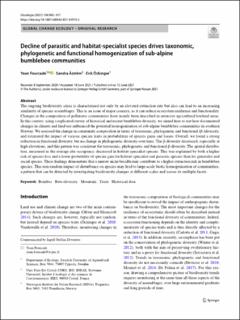| dc.contributor.author | Fourcade, Yoan | |
| dc.contributor.author | Åström, Sandra Charlotte Helene | |
| dc.contributor.author | Öckinger, Erik | |
| dc.coverage.spatial | Southern Norway | en_US |
| dc.date.accessioned | 2022-12-14T09:27:08Z | |
| dc.date.available | 2022-12-14T09:27:08Z | |
| dc.date.created | 2021-07-02T01:42:46Z | |
| dc.date.issued | 2021 | |
| dc.identifier.citation | Oecologia. 2021, . | en_US |
| dc.identifier.issn | 0029-8549 | |
| dc.identifier.uri | https://hdl.handle.net/11250/3037624 | |
| dc.description.abstract | The ongoing biodiversity crisis is characterised not only by an elevated extinction rate but also can lead to an increasing similarity of species assemblages. This is an issue of major concern, as it can reduce ecosystem resilience and functionality. Changes in the composition of pollinator communities have mainly been described in intensive agricultural lowland areas. In this context, using a replicated survey of historical and recent bumblebee diversity, we aimed here to test how documented changes in climate and land use influenced the potential homogenization of sub-alpine bumblebee communities in southern Norway. We assessed the change in community composition in terms of taxonomic, phylogenetic and functional (β-)diversity, and estimated the impact of various species traits in probabilities of species gains and losses. Overall, we found a strong reduction in functional diversity, but no change in phylogenetic diversity over time. The β-diversity decreased, especially at high elevations, and this pattern was consistent for taxonomic, phylogenetic and functional β-diversity. The spatial distribution, measured as the average site occupancy, decreased in habitat-specialist species. This was explained by both a higher risk of species loss and a lower probability of species gain for habitat-specialist and parasitic species than for generalist and social species. These findings demonstrate that a narrow niche breadth may contribute to a higher extinction risk in bumblebee species. This non-random impact of disturbance on species may lead to large-scale biotic homogenisation of communities, a pattern that can be detected by investigating biodiversity changes at different scales and across its multiple facets. Keywords: Bombus, Beta-diversity, Mountain, Traits, Historical data | en_US |
| dc.language.iso | eng | en_US |
| dc.rights | Navngivelse 4.0 Internasjonal | * |
| dc.rights.uri | http://creativecommons.org/licenses/by/4.0/deed.no | * |
| dc.subject | Bombus | en_US |
| dc.subject | Beta-diversity | en_US |
| dc.subject | Mountain | en_US |
| dc.subject | Traits | en_US |
| dc.subject | Historical data | en_US |
| dc.title | Decline of parasitic and habitat-specialist species drives taxonomic, phylogenetic and functional homogenization of sub-alpine bumblebee communities | en_US |
| dc.type | Peer reviewed | en_US |
| dc.type | Journal article | en_US |
| dc.description.version | publishedVersion | en_US |
| dc.rights.holder | © 2021 The Authors | en_US |
| dc.subject.nsi | VDP::Zoologiske og botaniske fag: 480 | en_US |
| dc.subject.nsi | VDP::Zoology and botany: 480 | en_US |
| dc.source.pagenumber | 905-917 | en_US |
| dc.source.volume | 196 | en_US |
| dc.source.journal | Oecologia | en_US |
| dc.identifier.doi | 10.1007/s00442-021-04970-3 | |
| dc.identifier.cristin | 1919946 | |
| dc.relation.project | Andre: Swedish Research Council Formas 2016-00667 | en_US |
| dc.relation.project | Andre: Swedish Research Council Vetenskapsrådet, 621-2010-5589 | en_US |
| cristin.ispublished | true | |
| cristin.fulltext | original | |
| cristin.qualitycode | 2 | |

